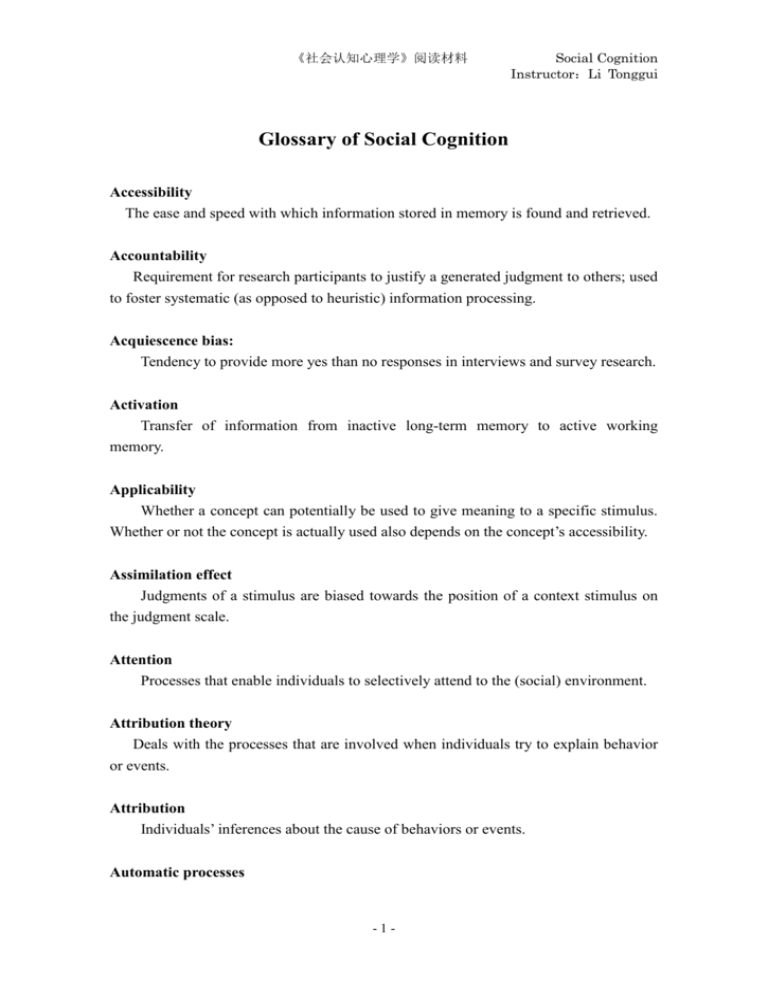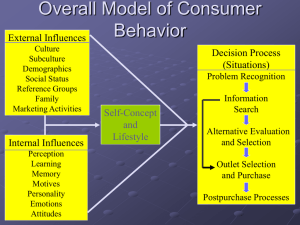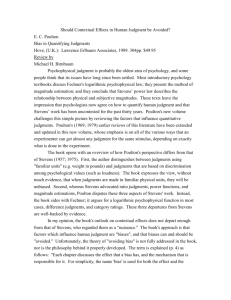Glossary of Social Cognition
advertisement

《社会认知心理学》阅读材料 Social Cognition Instructor:Li Tonggui Glossary of Social Cognition Accessibility The ease and speed with which information stored in memory is found and retrieved. Accountability Requirement for research participants to justify a generated judgment to others; used to foster systematic (as opposed to heuristic) information processing. Acquiescence bias: Tendency to provide more yes than no responses in interviews and survey research. Activation Transfer of information from inactive long-term memory to active working memory. Applicability Whether a concept can potentially be used to give meaning to a specific stimulus. Whether or not the concept is actually used also depends on the concept’s accessibility. Assimilation effect Judgments of a stimulus are biased towards the position of a context stimulus on the judgment scale. Attention Processes that enable individuals to selectively attend to the (social) environment. Attribution theory Deals with the processes that are involved when individuals try to explain behavior or events. Attribution Individuals’ inferences about the cause of behaviors or events. Automatic processes -1- 《社会认知心理学》阅读材料 Social Cognition Instructor:Li Tonggui Cognitive processes that are initiated and run without controlled processes, requiring no or very few attentional resources. Availability Judgmental heuristic for judging the frequency or probability of events on the basis of the ease with which relevant memories come to mind. Base rate Frequency of a characteristic in a relevant population or sample. Bottom-up processing Information processing that is driven by new stimulus input rather than by abstract knowledge structures in memory; see also top-down processing. Category Elementary knowledge structure. Class of functionally similar objects sharing one or more features. Cognitive miser Metaphor for the assumption that individuals try to avoid elaborative and extensive information processing, and often rely on simplifying short cuts and heuristics. Concept-driven processing See top-down processing Conjunction fallacy Overestimating the likelihood of a joint occurrence of several characteristics on the basis of similarity. Consistency theories Hold that individuals experience an aversive state when they perceive that they hold inconsistent beliefs about the social world. Because individuals try to avoid or eliminate this aversive state, they process information in a biased fashion so that perceived inconsistencies are reduced. Constructive memory -2- 《社会认知心理学》阅读材料 Social Cognition Instructor:Li Tonggui Self-generated, imagined, or inferred information is erroneously remembered as if it had been actually experienced. Context dependency The notion that social judgments (and the underlying processes) are highly dependent on the situational context in which they are formed. For example, a person may be judged more positively in one situation than in another simply because different standards of comparisons are accessible and applied. Contrast effect Judgments of a stimulus are biased in the direction opposite to the position of a context stimulus on the judgment scale. Controlled processes Cognitive processes that are consciously initiated by the individual, usually requiring substantial cognitive resources. Data-driven processing See bottom-up processing Encoding Comprises various processes that are involved when an external stimulus is transformed into an internal representation so that it can be retained by the cognitive system. This requires that the external stimulus is given some meaning by relating the new stimulus to prior knowledge. Episodic memory Memory of experienced events that are tied to particular times and places. Illusory correlations Observers believe they have seen a correlation in a series of stimulus events, although the actually presented correlation has been absent or clearly lower. Implicit association test (IAT) Computerized procedure for measuring association tendencies related to attitudes and prejudice, based on the sorting speed for attitude objects and relevant attributes. -3- 《社会认知心理学》阅读材料 Social Cognition Instructor:Li Tonggui Incidental affect Affective state that is perceived as independent of the judgmental target. Integral affect Affective state that is perceived as a result of the judgmental target. Judgmental heuristic Rules of thumb that allow quick and economic judgments even under high uncertainty. Linguistic inter-group bias The tendency to describe positive in-group behavior and negative out-group behavior in more abstract linguistic terms than negative in-group and positive out-group behavior. Metacognition Cognitive processes that involve knowledge about knowledge or processes; for example, knowing that we do not know the answer to a specific question. Mood as information The notion that affective states may themselves serve as relevant information in making a judgment. Mood-congruent recall The tendency to recall information that is congruent with one’s affective states, for example, recalling positive events in happy moods and negative events in sad moods. Mood management The notion that individuals are motivated to maintain positive affective states and to eliminate negative affective states and consequently engage in cognitive processes that allow them to attain these goals; for example, to intentionally think of positive events when in a sad mood. Network models Conceptualizations of human memory that assume a system of nodes and -4- 《社会认知心理学》阅读材料 Social Cognition Instructor:Li Tonggui connections. Positive testing Selective information search for those events or behaviors that are stated in the hypothesis under focus. Priming effect The finding that a schema is more accessible and hence more likely to be activated when it has recently been presented or used in the past. Representativeness Representativeness heuristic for judging category membership on the basis of various aspects of similarity. Retrieval Processes that are involved when individuals retrieve information from long-term memory into working memory. Salience The distinctiveness of a stimulus relative to the context reflected in its ability to attract attention (for example, a male in a group of females; a group of people of whom one is in the spotlight). Schema Knowledge structure linked to adaptive function. Once a schema is activated by specific events, specific reactions are triggered. Script Temporally organized behavioral routine. Self-fulfilling prophecy An expectancy-based illusion in social hypothesis testing. Subject persons treat object persons in such a fashion that object persons eventually verify their original (often unjustified) expectations. Self-reference effect -5- 《社会认知心理学》阅读材料 Social Cognition Instructor:Li Tonggui Memory advantage for stimuli that have been encoded or judged in relation to the self. Shared-information effect In-group decision making, information shared by different group members is more likely to be considered, and is given more weight, than unshared information that is exclusively available to individual members. State-dependency Describes the general finding that memory performance is enhanced if individuals are in the same psychological state (e.g., the same mood) at both the time of encoding and the time of retrieval. Stereotype Category-like knowledge structure associated with a social group, judgment of persons on the basis of characteristics of their social group. Subliminal On a subconscious level; out of awareness Top-down processing Information processing that is driven by general, superordinate knowledge structures in memory (e.g., schema, stereotype) that influences the perception of new stimuli; see also bottom-up processing Truncated search process When searching in memory for applicable information (e.g., for encoding, or for computing a judgment), individuals are unlikely to search for all potentially relevant information but instead truncate the search processes. Due to this truncation, information that has a higher accessibility is more influential. Working memory The part of our memory system that is currently activated; it has little processing capacity. In order to enter into long-term memory, information has to pass through working memory. Conversely, information from long-term memory needs to enter working memory in order to affect ongoing processes, judgments, and behaviors. -6-






